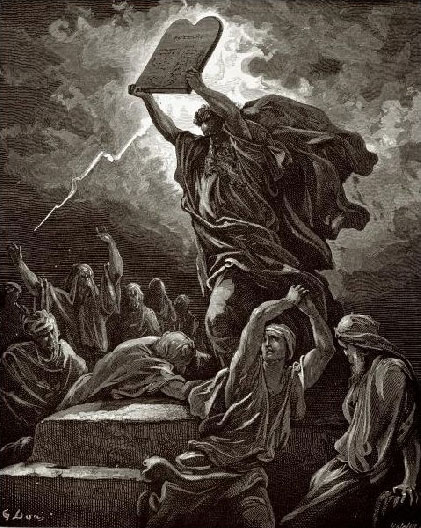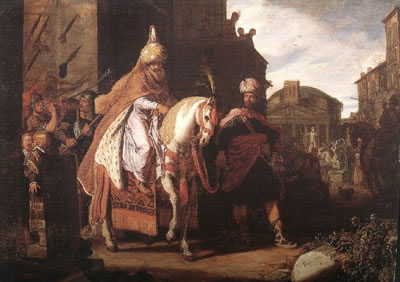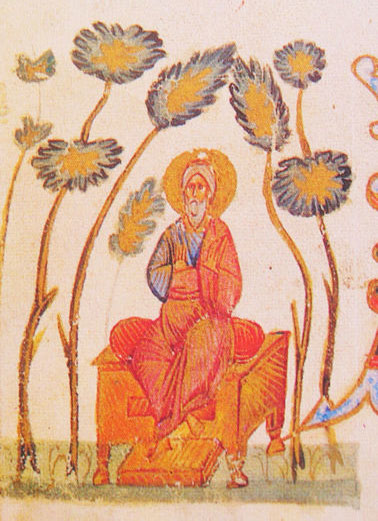Inside Themselves

The content of this post has been revised and included in Bible Matrix II: The Covenant Key.

The content of this post has been revised and included in Bible Matrix II: The Covenant Key.
There is a lot of truth in theonomy. But things have changed since the time of Moses. At that point, the church and state were basically one.
After the exile, things were different. The role of the Jews was to be priests within the Gentile state. They no longer had the right to administer capital punishment. When they witnessed faithfully, there was a Jew at the emperor’s right hand, steering the empire for God’s people and their stand for the truth.
By the time of Christ, instead of a Joseph, Daniel or Mordecai, the Jews had a Haman, a Herod. Instead of being a nation of priests, they wanted a king like the Gentiles. This makes Herod even more culpable for his role in the death of Christ, standing (legally) at the right hand of the power.
I believe the church today is exactly the same. The church administers ‘inhouse’ justice through excommunication. When the church is faithful in disciplining itself, and thus witnesses faithfully, it stands side by side with the state in administering capital punishment. Our failure to witness has led to ‘life’ for murderers and death for the innocent.
The Bible is clear on the shedding of innocent blood. A murderer dies to atone for the blood he shed. It is judicial. Correlating capital punishment with abortion is a total misunderstanding of justice.
As in AD70, perhaps all the innocent blood shed in this gospel age will be atoned for by the final generation. The murderers are marked like Cain for now, but Abel’s blood will be atoned for.
 I puzzled over Ezekiel chapters 38 and 39 for years. Bible commentators suggested many things but nothing seemed to fit the historical context of the surrounding chapters. It seems James B. Jordan was the first to put the pieces together.1
I puzzled over Ezekiel chapters 38 and 39 for years. Bible commentators suggested many things but nothing seemed to fit the historical context of the surrounding chapters. It seems James B. Jordan was the first to put the pieces together.1
 Analysing the repeated structures of Scripture can bring some insights. Most interpreters would call these speculation, but that’s like saying Middle C is not the same note as High C. Such an attitude renders very sharp people obtuse. And these structures are repeated many more times than there are octaves on the piano.
Analysing the repeated structures of Scripture can bring some insights. Most interpreters would call these speculation, but that’s like saying Middle C is not the same note as High C. Such an attitude renders very sharp people obtuse. And these structures are repeated many more times than there are octaves on the piano.
The LORD will attack those nations like a warrior fighting in battle. He will take his stand on the Mount of Olives east of Jerusalem, and the mountain will split in half, forming a wide valley that runs from east to west. Then you people will escape from the LORD’s mountain, through this valley, which reaches to Azal.” (Zechariah 14:3-5)
diSpENSATIONALISTS love to quote verses from Zechariah and apply them to modern Jews. While this breaks all the rules of interpretation (context, first audience, book structure, common sense, etc.), those who realise its events were all fulfilled, culminating in the first century, still have a lot of trouble with the details. But the answers lie in Old Testament typology.
Not only does the entire book of Zechariah follow the ‘Egypt to Canaan’ pattern, each of the ‘post-vision’ chapters does so individually. There is too much detail to go into here, but I want to deal with the splitting mountain.
The Ark was the Lord’s footstool. It, along with both the incense and bronze altars, had to be purified with blood. The Lord will only stand in a clean place, and indeed even required His priests to have clean feet. As a square altar, Canaan was purified with blood by Abraham. It was purified with blood again under Joshua in the ‘devotion’ of Jericho. Immediately after this victory, the people were divided between Mounts Ebal and Gerizim, one for the blessings of the Law and one for curses (Joshua 8). Blood, and a split mountain, made a way into the new Land.
Here’s where the structure of the passage is important. It follows the feasts pattern (Lev 23) and this section appears at Atonement (Covering). One goat was blessed and ascended to God; the other carried the curses to destruction (ez azal). As the Lord’s footstool, the Mount of Olives was divided to the north and the south, just like the Temple veil was torn in two. With Christ’s death as Passover, Olivet became symbolically like Mount Gerizim and Mount Ebal at the birth of a new Promised Land, the heavenly Canaan, the New Jerusalem.
The mountain was split from the east to the west. The faithful would enter from the east, the opposite direction to Adam’s expulsion. The death and resurrection of Christ tore the Garden door open, and there were earthquakes. The death of the first century church under Herod/Rome also tore the Land in two. Old Israel became the garment of the old High Priest, torn under the Covenant curse (Matthew 26:65) to be eaten by birds and beasts.
Revelation also uses the symbolism of two mountains. One was a flaming Sinai, thrown into the Gentile sea as Jesus promised (curses – Matthew 21:21). The other was a new, heavenly Zion – the one mentioned by the writer of Hebrews (blessings – Hebrews 12:18). The saints prayed as Jesus commanded and Judaism and Christianity were split in two when Christ came in vengeance in AD70. Judaism went to Azal.
When God is making something new, He begins by tearing something in two. If it happens to be you, the something new might not be you. This is something Adam knew.
(Zechariah’s visions showed two bronze mountains allowing the Restoration era ‘gospel’ to go out into the world after the rebuilding of the Temple in 6:1. The events of Zechariah’s day prefigured the restoration of Israel in the Christian church.)
James B. Jordan, following the God-given office of Cyrus as shepherd over Israel (Isaiah 44:28), interprets Zechariah 11 as a prediction of events under Greek rule, rather than Roman:
“The wicked Hashmoneans took over the Temple for themselves, and did not give glory to God and restore the true High Priest. The Hashmoneans “buy” the Temple for thirty pieces of silver, but Yahweh rejects their offer, which treats Him and His people as slaves. These evils result in the Jews being broken apart and set at each other’s throats.”1
Either way, the pattern is the same, as the Jews’ apostasy under Greek rule was repeated under Rome, with the “Temple” they sold in the second instance being Christ Himself. Both “Greek” and “Roman” interpretations link the events of chapter 10 to chapter 12, and echo the judgments upon false shepherds by the pre-exile prophets. And in both cases, it is the “Temple” seen by Ezekiel that is being judged. The flock is divided and the Temple made desolate under Antiochus Epiphanes (Greece), and under Christ and Titus (Rome).
The most important factor is that in both events, the Jews’ compromise left them without a true High Priest, and thus no true Atonement.
_______________
See James B. Jordan, The Handwriting on the Wall, p. 585-587.
An example would be the seven feasts listed in Leviticus 23 which provide a common literary structure. Revelation 1-11 follows this heptamerous pattern, with Jesus’ ascension in 4-5 as Firstfruits. Revelation 12-19 also follows this pattern, with the rise of the false prophet and harlot as an ironic counterfeit of Firstfruits.
In Revelation 16, in the second major cycle, the “Ascension” section concerns the fall of Babylon and its internal structure is upside down to make the point. Reaching the end of this second cycle, the “Atonement” section is even more tricksy. Because the seven feasts are chiastic (symmetrical) with Pentecost at the centre (actually the scorching fire of un-Pentecost), Passover (Red Sea) and Atonement (Jordan) correspond (feast 2 and feast 6). So even though the seven bowls deconstruct the Old Covenant feasts – running through their order backwards – the “un-Passover” of bowl 6 is actually the “Atonement” Joshua-conquest of the church, the new Israel. So this bowls section is a subtle see-saw, working from 7 down to 1 for the Old Covenant, and from 1 to 7 for the New. This becomes apparent at bowl 6, when, at Un-Passover, (the new church’s day of covering) old Israel is exposed, uncovered, before God.
Amazing.
or The Knowledge of Good and Evil is Always a Two-Edged Sword
“Nobody has the power to bless or be blessed who has lost the vigor to curse. Our society is so polite that it cannot curse social evils and prefers to blaspheme God instead.”
- Eugen Rosenstock-Huessy
Judgment is not destruction. Judgment is assessment. For every beast rejected and sent to outer darkness, there is a redeemed beast that ascends to God. AD70 was the ultimate Yom Kippur, the outworking of the cross. Passover always leads to the Day of Atonement, the Day of the Lord when the flaming sword turns to and fro.

or Hyperpreterism: stuck on the starting line
Hyperpreterists take great delight in pointing out the inconsistencies in what they refer to as “partial” preterism. Matthew 25 is a good example. If we are going to (rightly) interpret Matthew 23 and 24 as referring to the destruction of centralised worship (the old age) and the beginning of a new age of righteousness, surely Matthew 25 is within the same context?
On this one, I agree with the hypers. Matthew 25 is fulfilled… Continue reading
“…though Jews returned to the land after the decree of Cyrus, they did not enjoy the fruits of it (Haggai 1:1-11). They were still alienated from the land. They did not really occupy it until they rebuilt the Temple, which was completed in the sixth year of Darius, 20 years later.”1
Darius listened to those who opposed the Jews and ordered the Temple reconstruction to officially cease, so the Lord raised up two witnesses, Haggai and Zechariah. Haggai would chastise the people for neglecting the house of God, and stir up their hearts to finish it. Zechariah would deal with the spiritual war going on behind the scenes.
Zechariah’s visions perform the same function as Abram’s animal sacrifice. (In Abram’s time, there was a famine in the Land, and later it did not support Abram and Lot’s flocks). In Zechariah, the mediator who is “passed over” is not Abram but Joshua the High Priest. The sins are atoned for again, but not with animal sacrifices. In Zechariah it is the Angel of the Lord who steps in, chases away the accusations of Satan (as the ravens), and provides clean robes as a New Covenant.
Then the Temple could be completed, and the abundant fruits of a recreated Land were enjoyed by a new Israel.
________
1 James B. Jordan, Jubilee,
Biblical Chronology Vol. 5, No. 4, www.biblicalhorizons.com